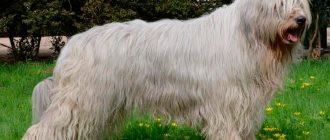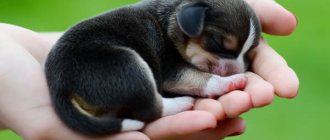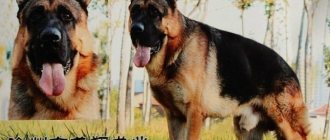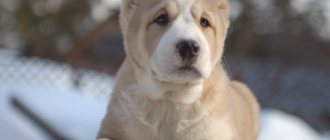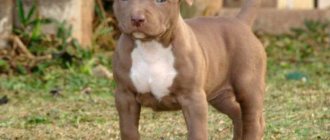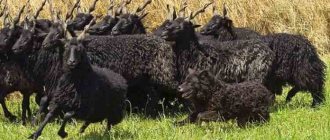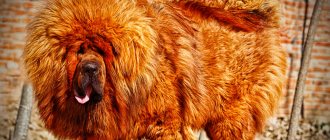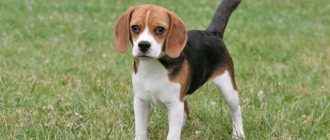History of the Chow Chow breed
White Chow Chow
Today there is no reliable information about when exactly the history of the Chow Chow began. But the fact that it dates back several thousand years is beyond doubt. According to some data, back in the 3rd millennium BC. e. in the palace library of the Chinese emperors there were records about this amazing breed, which, unfortunately, have not survived to this day.
One version of the origin of the breed says that the first dogs of this type appeared in China as “gifts of peace” that the Mongol conquerors presented to the emperor. The bear dog came to the Mongols as a military trophy during clashes with the indigenous peoples of Siberia. Archaeological finds confirm that the ancestors of the Chow Chow lived in this territory.
The question of the genetic roots of the representatives of the breed remains open to this day. Many experts are inclined to accept the version about the origin of the chow chow from polar wolves. The fashionable legend that the first dogs of this breed appeared as a result of an interspecific crossing of a husky and a polar bear does not stand up to criticism.
Once in China, Chow Chows were initially the property of only the courts of high-ranking nobles. But gradually interest in animals faded away, and dogs spread throughout the country, they could even be found in the homes of poor Chinese. Control over the purity of blood was lost. The situation was saved by the monks of Buddhist monasteries in Tibet, Manchuria and Northern China, who carried out careful selection work and kept pedigrees of blue and black chow chows.
Europe greeted the “bear” dog as a strange beast from the distant Celestial Empire. The first “fluffies” appeared here in 1780 and for almost a hundred years they were perceived only as exotic animals. The situation changed in 1865, when Queen Victoria, fascinated by the plush miracle given to her, showed interest in the breed. In 1887, the British began breeding Chow Chows, and eight years later the breed standard was approved and the first Chow Chow Club appeared in the Old World.
The Russian history of the breed goes back about eighty years, when the animals appeared in the Soviet Far East. Later, after 1945, some of the dogs were brought to the USSR from the eastern regions of Germany. A more or less stable population was formed only in the 60s of the last century. It became possible to get closer to world quality standards for the breed only after 1976, when purebred Chow Chows from recognized and titled producers were brought to the Leningrad Kennel Club.
Chow-chow female and male
Chow chow puppies
Chow Chow colors
The standard implies only completely uniform Chow Chow colors:
- The red color (red) has many shades: from bright red to light golden. Newborn red chow chow puppies have a black mask on their face and a dark brown coat color. As they mature, the fur becomes red in color. The nose, lips and gums are black, the tongue is dark blue, the eyes are brown.
- Dogs with black coloring should have a completely uniform coat, with the exception of a gray tint on the tail and paws. Black Chow Chows can bleach in the sun, resulting in a chocolate color, but there is no separate chocolate color in nature.
- Blue wool is a steel gray color with a slight hint of blue. Sometimes it may have a reddish tint. The nose and eyes of dogs with this color are dark gray, the tongue and palate are dark blue, and the gums and lips are blue-gray.
- The color of the cinnamon is the most unique. It can have different shades: from beige to rich golden. Dogs with this color have light eyes and a pinkish nose.
- Cream and white coats are the least common. This color is valued higher than others at shows, and puppies with this color are the most expensive. Creams have a black or gray nose, dark eyes, and apricot-colored ears.
Breed standards allow shades of these colors, but not markings or spots. Professional breeders do not recommend breeding dogs of different colors; mating them can produce spotted litters. Mixed Chow Chow is not recognized by standards.
Why "chow-chow"?
As well as versions of origin, there are several interpretations of the name of the breed.
- Thus, the word “chow” in Chinese means “an animal that can be eaten.” And although gastronomic preferences for dog meat are more likely to be typical of Koreans, China has also never disdained this dish.
- However, the same Chinese have the word “kau” - “dog”, which is very close in sound to “chow”. The version is less bloodthirsty, therefore more popular.
- The rich Chinese language gives us another explanation. The word "Chow" denotes a dog distinguished by great strength and courage - these are the traits that are characteristic of real Chow Chows.
- The European version refers us to the English “chow-chow” - this was the name of special premises on merchant ships that transported dogs of this breed across the ocean.
Nicknames of Chow Chow
Representatives of the species have an unusual appearance, so they need to be given interesting and non-standard nicknames. The name should reflect the individual characteristics of the pet, be sonorous and memorable. The most popular nicknames for chow-chow boys:
- Archie;
- Graph;
- Baron;
- Black;
- Thunder;
- Watson;
- Jack;
- Pooh.
Common names for girls:
- Alma;
- Donna;
- Julia;
- Greta;
- Squirrel;
- Milady;
- Isabel;
- Jesse.
Chow Chow Appearance
Fluffy handsome man
The Chow Chow is one of the most recognizable dog breeds in the world. Amazing fur and dark tongue are the reasons for the animals' enduring popularity.
Height
The height at the withers of a male is from 48 to 56 cm, of a female - 46-51 cm.
Weight
An adult male weighs 25-32 kg, a female – 20-27 kg.
Head
The Chow Chow's skull is flat, wide, with good filling under the eyes. The stop is not pronounced.
Muzzle
Wide, medium length without a “foxy” point. The nose is wide and large, usually black. For fawn and almost white dogs, a light color is allowed, and for cinnamon (cinnamon color) and blue chow-chows, a natural shade of the lobe is allowed. The palate, lips (preferably, and gums) are black. The tongue is blue-black.
Eyes
Oval, medium size. The pupil is clearly visible. Chow-chows of blue or cinnamon color may have eyes that match the color of their coat.
Ears
Thick, small in size, rounded at the ends. Wide set, erect, but slightly inclined towards the eyes, which gives the muzzle a frowning expression.
Neck
Harmoniously curved and well set on the shoulders. Powerful, not short.
Chow chow muzzle
Back
Straight, short, strong with a powerful loin.
Breast
Deep, well developed with pronounced but not barrel-shaped ribs.
Tail
The Chow Chow's tail is set high and lies on the back.
Front legs
Absolutely straight, medium length. The backbone is strong.
hind legs
Black chow chow
Powerful, medium length. The angles of the hock joints are minimal, which gives rise to a “stilted” gait characteristic only of this breed.
Paws
The Chow Chow's paws are small, rounded, and raised at the toes.
Wool
Long – very thick, straight and erect with fairly coarse topcoat and soft undercoat. It forms a characteristic “lion’s” mane around the neck, and long “pants” on the back of the thighs are well defined. Intentional shortening of hair that changes the appearance of the dog is under no circumstances allowed.
Short (smooth) – very thick, has a plush structure. The hair is located perpendicular to the body.
Color
Be sure to have uniform pure colors - black, fawn, cinnamon, red, especially valuable - blue and white. Shades of the main color are allowed, but never spots.
Any deviation from the standard is a deficiency or a disqualifying feature, depending on the degree of its manifestation.
article by Mona Selbach, owner of the Tsingfu nursery (Norway) and Anita Westlake, owner of the Baytor nursery (England)Originally written by Mona K Selbach (Tsingfu kennels, Norway) and Anita Westlake (Baytor kennels, England)
Recently, dog breeders have become more and more interested in “other coat colors” than the usual red and black. Trying to produce other colors in the same litter leads to confusion about what colors to expect in the litter, as well as how to know what color a newborn puppy will ultimately be when fully grown. Experts may also have trouble identifying colors: is it cinnamon or red, black or blue, cream, cinnamon or perhaps a light red?
RED
appears in all nuances, and the color of the coat varies from light red to brownish-red with and without lighter shades on the coat around the neck, tail and belly. Dark red (red) coats are more common with shorter hair and less hair on the neck than the lighter red dog. Red is red and is easier to define.
Red Chow Chows bred to Reds will usually produce only Red puppies. BUT if there are blue or cinnamon genes on both the sire and dam side, then there may also be cinnamon puppies in the litter.
Red chow-chows bred to cinnamon produce cinnamon or red puppies, BUT if there are cream chow-chow genes on both sides, then you can even get cream-colored puppies in the litter if a red chow-chow is bred to a red chow-chow or cinnamon.
Due to the fact that black is the dominant color of the Chow Chow, two reds, or one red and one cinnamon, or two cinnamon, will never produce black or blue puppies in the litter. Newborn puppies may appear dark brown if they are dry. Some red puppies are born with a black mask. When the puppy grows up, the black color on the face disappears.
BLACK
- This is another common Chow Chow color. Black hair grows along the entire length of the coat and may be with or without a lighter shade on the neck, tail and legs. "Old" black wool may have a gray or reddish tint. Because of this, the Chow Chow is considered to have an uneven coat color. Black is usually easier to define, black is black.
Black Chow Chows bred to blacks can produce black, red, blue, cinnamon and even cream puppies (if their genes are present).
A black (blue) offspring from two black (or from two blue or one black and one blue) parents can be homozygous. This means that this Chow Chow will not be able to father or mother puppies of any color other than black or blue. This particular Chow Chow carries the black and blue genes.
Conversely, a heterozygous black (who has a heterozygous black (blue) father and mother) carrying chow chow genes for both black and other colors.
Black Chow Chows bred to blacks can even produce cream puppies in addition to all other colors if the genes for those are present on both sides, unless of course either parent is homozygous black.
Some experts have trouble recognizing the true expressiveness of a black Chow Chow's color, as opposed to a red Chow Chow, where expressiveness can easily be noted. Black puppies are shiny black when they are dry and also when they are new and wet.
CIMT
Chow-chow - diluted red. The cinnamon coat can range from light beige to almost light brown with or without light shades on the neck, tail and legs. I like to divide them into "blue cinnamon" and "red cinnamon".
Sometimes it is very difficult to distinguish red from cinnamon in the ring, but cinnamon dogs have the same eye and nose color as their coat color. Fawn dogs may also have a silvery coat, especially around the neck. Blue cinquefoil is easier to recognize than red cinquefoil, the fur on their neck is grey/blue/silver tinged and their nose color is grey/bluish. They also have better pigmentation in the mouth and lips than red cinquefoil.
Cincinum Chow Chows bred to cinnamon can only produce cinnamon puppies. Theoretically, fawns with cream dog genes could also produce cream puppies, but I have not personally encountered such cases.
Fennel Chow Chows bred to Reds can produce red and cinquefoil puppies (or perhaps even cream-colored puppies if such genes are present).
Fawn Chow Chows bred to Blue Chows can only produce Fawn and Blue puppies. (I have not heard of any cinnamon and blue chow chows mating with each other that would produce cream puppies, but this is possible if the genes are present).
Fennel Chow Chows bred to blacks can produce puppies of all colors if the genes for those colors are present in the parents. Fennel Chow Chows bred with cinquefoil over several generations can produce a lighter colored species with yellow eyes and a very pale blue tongue. This is, of course, undesirable.
Fennel puppies are often very difficult to distinguish from blue puppies when they are newborns. Both colors appear gray. If you examine the fur on the cheeks and carefully examine the fur on the back of the front legs, you will find a pinkish tint in cinnamon puppies. The blue cinquefoil is even more difficult to distinguish from the blue color. Look at the claws and ears of the puppies; cinnamon puppies are gray in color, while blue puppies are much darker.
If you think your red puppy might be a cinnamon, look at his nose; red puppies have a black nose, while cinnamon puppies have a gray nose. BLUE
– diluted black. The blue coat runs the entire length of the coat and can be with or without lighter spots on the neck, tail and belly. The blue coat darkens as the Chow Chow matures, so a light blue puppy will eventually not be the same color when he grows up. The “old” blue coat becomes gray or reddish (like black chow chows); but this does not mean heterogeneity of color. Blue Chow Chows have eyes and noses that are the same color as their fur.
Blue Chow Chows have a silver tinge on their necks. This never happens with black Chow Chows. This way you can differentiate between dark blue and black dogs in the ring.
Blue chow chows bred to blue produce blue or cinnamon puppies. (As I said earlier, I do not know of cases where cream-colored puppies were produced from such a mating, as can be the case if both parents are carriers of such genes). Blue Chow Chows bred to cinnamon produce only blue or cinnamon puppies.
A blue dog with black parents, blue parents, or one black or one blue parent can be homozygous and thus produce black or blue offspring.
Heterozygous Blue Chow Chows bred to Chow Chows of other colors can produce puppies of all colors unless they are bred to Chow Chows or Blue Chows.
If you simply breed Blue Chow Chows with Blue Chow Chows over several generations, you may end up with chocolate-colored puppies. They look like they've been dipped in milk chocolate, but puppies of this color have yellow eyes and a pinkish tongue, which, as everyone knows, is not up to standard.
Blue puppies look gray when they are new, but they usually look blue-gray when they are dry. The ears and claws are darker than the gray of cinnamon puppies.
CREAM
Chow Chows can come in a variety of shades from white to a creamier yellow hue, but the overall appearance of the coat should be cream rather than yellow or orange. The ears are usually light brown in color. According to Fédération Cynologique Internationale standards, a "snow nose" is permitted, and the nose is pinkish in color rather than black. A puppy's nose can be black, but it usually becomes lighter as the puppy grows. A "snow nose" may be a sign of cream color in the ring if the dog's color is so dark that it may be a light cinnamon or a very light tan.
Cream Chow Chows bred to Cream will produce only Cream.
Cream chow chows bred to red ones will, no matter what, produce black ones. Cream chow-chows bred to reds also produce red, cinnamon, blue, black and cream.
Cream chow chows bred to cinnamon also produce blue chows.
Cream Chow Chows bred to black or blue Chow Chows can produce all colors as long as the Black and Blue Chow Chows are not homozygous.
Cream colored puppies are usually born bright white with light brown ears. It's impossible not to recognize the cream-colored puppy even when he's still wet. I don't remember ever seeing a completely white Chow Chow with white ears.
Breeding dogs for colors is a delightful activity, but remember that Chow Chows are bred for quality, not just to produce unusual colors.
© 2007 Translation from English by E. Pokinchereda. Reproduction of the material in any form is prohibited.
Return to the library »»
Photo of an adult chow chow
Origin story
The thousand-year history of the appearance of the breed is overgrown with many stories, traditions, legends, some of which even have a mystical context. As early as the second century BC, the ancestors of modern Chow Chows were widely bred in Ancient China. Materials that have survived to this day contain descriptions of powerful dogs with fluffy fur, similar to lions.
In China they were revered and treated as sacred animals. The dogs lived in the imperial domains, their owners were exclusively rich, noble people. At the same time, the ancestors of the Chow Chow were bred in Mongolia. The characteristics of the breed in that area were slightly different, especially in color - it had a pronounced blue tint. In Mongolia, dogs were not treated with the same respect as in China; they were bred solely for practical purposes. They became guards, beasts of burden. The ancestors of the Chow Chow in this territory differed from their relatives from China in their aggressiveness and courage.
The first modern breed club was organized in the 19th century. Since 1906, the Chow Chow has been an officially registered breed, whose fans have contributed to the spread of dogs throughout the world.
Character of the Chow Chow
As original as the appearance of the Chow Chow is, its character is equally non-standard (as applied to dogs). People who know about the chaushka first-hand claim that it is an arrogant and heartless animal, and the owners of these unusual dogs unanimously speak of the kindness, devotion and responsiveness of their pets.
Chow chow with a child
The main character traits are independence, poise and dignity. This dog will even show love for its owner with special restraint, hiding endless devotion inside. Like all large dogs, the Chow Chow independently chooses the leader of the pack. And it is not at all a fact that it will be the one who brought the puppy into the house. Other household members will also receive their share of favor and courteous treatment, but the animal’s heart will belong only to the “leader” all its life.
External manifestations of love are very restrained. The dog whines almost inaudibly and lightly nuzzles its owner. Delight from communication can also be indicated by a barely noticeable twitching of the tail.
Dissatisfaction usually manifests itself in a dull growl, which, depending on the degree of concern of the dog, has different shades.
Newborn chow chow
All Chow Chow owners note an amazing, almost telepathic ability to sense the owner’s mood if he is upset or unhealthy in some way. But this dog will not understand and will not approve of excessive emotionality and hot temper.
If you have a child in your house, explain to him that this stuffed animal is not a toy at all and will not tolerate pain and excessive pranks even from members of his pack. If a child offends an animal, he will never be able to find a common language with him.
The Chow Chow's attitude towards strangers is always wary and distrustful. The dog usually does not show aggression, but it will not accept unsolicited affection from a stranger.
Relationships with other animals cannot be called simple. Chaushka will love the cat she grew up with, while the tailed one seen on the street will be pursued by her at every opportunity. They usually show no interest in oncoming dogs. If the first acquaintance does take place, then the decision made by the Chow will never change - either it is an enemy, or a friend, or just an acquaintance who just needs to “just politely nod in response.” Of the other dogs you keep in your home, the Chow Chow will only tolerate a member of its own breed of the opposite sex.
The Chow Chow does not celebrate a coward. If aggression is shown towards itself, the dog will fight to the bitter end without hesitation. Powerful jaws, large size and thick fur that protects against bites are good arguments in any fight.
A chow will rush to protect its owner without hesitation, even if it has not been trained in security work. He just loves you and is ready to give his life for it.
Description of the breed
Chow chows are medium-sized dogs, males are slightly larger than females. The height at the withers is 46-56 cm, life expectancy is 12-15 years. The weight of the animals is 20-30 kg, but this is not a fundamental indicator. The main thing is that the dog is proportionally built.
The breed is characterized by the following standards:
- The body is strong and square in shape, the back is straight with good posture, the chest is wide with barrel-shaped ribs. On the wide loin there is an adjacent tail, which continues the line of the top. The neck is massive, slightly curved.
- The head is massive, the transition from the skull to the nose is weakly expressed. Small erect ears are inclined towards the eyes, slightly brought together, which gives the dog a somewhat dull appearance. The nose is large and black, but in white and cream dogs it is lighter. The eyes are dark or black, oval shaped, cinnamon and blue dogs may have gray eyes.
- The teeth are large and strong, arranged in a scissor-like manner. The Chow Chow breed of Chinese dog has a distinctive feature: a dark blue tongue and black gums. Dog handlers reject animals that have a blue or black tongue.
- The limbs are muscular with strong bones. The front ones are of medium length, straight. The hind limbs have straightened knee joints, which determines the peculiar gait of the animals: the dog moves as if on stilts. The paws are round and compact.
Exterior
Depending on the length of the coat, there are 2 types:
- Long-haired - with straight and coarse center hairs and a soft fluffy undercoat. A beautiful voluminous “collar” fits the neck, and there are feathers on the forearms and hind legs.
- Short-haired individuals have straight, non-adherent hair, plush to the touch.
Color
The color is almost uniform, with lighter hair around the neck, hind legs and tail allowed. Depending on the color of their coat, dogs are:
- Black in color, it is dark gray on the paws and tail. In the sun, such animals fade and become chocolate-colored. However, there is no brown color in the animal breed.
Black color - Red in color, it varies from red to golden. Small puppies may have a dark brown coat, but over time they will develop a red coat.
Red color - Cinnamon (mustard) color, this is the rarest color, it can acquire a beige and golden hue. Cinnamon Chows have a pink nose and light eyes.
Cinnamon color - Blue or steel color with a bluish tint. The dog's nose and eyes are gray, and his gums and tongue are dark blue.
Blue color - White or cream in color, such individuals are extremely rare and are more expensive than others. The nose and eyes are black or gray, and the tips of the ears have an apricot tint.
White color
In appearance, these are strongly built animals with a proud posture and a lion's mane. They are not hasty in their movements, they surprise you with their dignity and restraint of character. The puppies have all the distinctive features of the breed.
Education and training
Outwardly resembling a huge plush toy, Chow Chows are distinguished by a very firm and even somewhat wayward character.
Chow chow on a leash
Raising an obedient dog turns out to be a task that requires a lot of patience, dedication and consistency.
Raising a Chow Chow puppy should start from a very early age. Nature has endowed this cute fluffy ball with such willpower and integrity of character that only a true leader will obey the chow. Moreover, your leadership should be calm, confident and not subject to the slightest doubt. A hysterical aggressive person will never cope with this dog. Flirting and lisping will also not achieve results. The pet, sensing the weakness of the owner, will itself take the place of the leader and it will be almost impossible to make changes to such a hierarchy.
For successful upbringing, it is necessary to socialize the animal as early as possible. Walk him in crowded places more often so that the puppy gets used to the idea that there are many strangers besides you. This will gradually level out the innate hostility towards strangers. Chow Chows are very jealous of the inviolability of their home. A situation when guests come to the house and (in the puppy’s opinion) allow themselves to move uncontrollably around its territory can cause stress in the dog and a subsequent aggressive reaction, so you should try as quickly as possible to teach the baby to be calm about new faces, smells and voices .
Wet chow chows
A big plus in raising Chow Chows is their innate cleanliness. The puppy very quickly understands where to go to the toilet and learns to be patient from walk to walk. But do not abuse this ability - after sleep and every feeding, the dog should be taken outside.
Training a Chow Chow at home seems to be a very problematic undertaking. A representative of this breed simply will not follow orders that he considers incomprehensible or stupid. If you don’t have enough time or feel even the slightest doubt about your abilities, it’s better not to start the task. Immediately place your pet in the hands of an experienced instructor, otherwise it will be extremely difficult to correct the consequences of training.
Experts note that the execution of even a simple command takes place in several stages. First, the dog will evaluate the appropriateness of the command in a given situation, then decide how determined you are to carry it out, and only after realizing that your willpower cannot be overcome, will it perform the required actions. If you give up, the chow will continue to do its own thing. The situation is even more difficult with the execution of service commands, especially endurance. Well, the animal doesn’t understand why it needs to stay in the same position for a long time. And if he doesn’t understand, it means he won’t do it.
The main difficulties in training Chow Chows are encountered when working with males. Girls are more flexible, obedient and sociable, and do not strive for leadership in the pack as much as the stronger sex.
Character
The Chow Chow is a one-owner dog. She shows friendliness towards all family members, but only feels love and true affection for one person. He treats children coolly and does not tolerate even harmless pranks.
She expresses emotions with restraint, for example, she greets a person she likes with a light trembling of her tail. Fear and panic are inaccessible to animals. The pet is able to show sympathy, for example, to come up and lay its head on the owner’s lap.
The character traits of the Chow Chow are calmness, pride and stubbornness. Dogs are smart and understand perfectly well what is required of them, but they carry out a command only when the owner orders it. They do this reluctantly and think for a long time before fulfilling the demand. They treat strangers coolly and in some cases show aggression.
Chow chow puppies
Chow chows are big owners. Toys, bowls, a place to sleep and even a house - everything belongs to them. For example, if you have a garden, the dog considers it his own. Therefore, representatives of the breed make wonderful guards. Shows little tolerance towards other living beings and considers them his competitors. To prevent a dog from showing aggression in the future, it must be socialized as a puppy.
He does not like to bark in vain; he expresses aggression by growling. If a pet is happy with something, it shows its approval by grumbling. The animal is leisurely and does not like fast movements. Therefore, if you need a companion for running in the park or other active activities, it is better to look at another breed.
Care and maintenance
Chow chow at a puppy show
The conditions of a city apartment are quite suitable for keeping a chow chow. This dog has a balanced and calm character and, when alone, will never howl loudly, annoying neighbors, or damage furniture. The chaushka is also amazingly clean, which all owners note with special pride.
Thanks to its special structure, the coat of dogs of this breed practically does not get dirty, and when dirty, it cleans itself perfectly, so experts do not recommend bathing your pet more than 2-3 times a year. Of course, before entering the exhibition ring you cannot do without this procedure.
Contrary to popular belief, you should not brush your dog every day when it is not shedding. It is enough to perform this procedure once a week using a sparse comb. The Chow Chow's coat is not prone to matting. The exceptions are the armpits and behind the ears. These areas need to be monitored more closely. During the molting period, the fallen undercoat remains on the coat and is easily removed by combing, which these days requires systematicity.
Connoisseurs of the breed note that richer, longer and denser hair is characteristic of males. A chow chow that spends a long time on the street or is kept in a specially equipped enclosure looks even more luxurious. This applies to adult dogs. In puppies up to six months of age, the body is covered with fluff, which quickly falls off, gets wet and dries very poorly. You should carefully look after the condition of your baby’s coat and try not to bathe him until the first adult shedding.
The procedures associated with cleaning a dog’s ears and teeth are no different. But trimming the claws is usually not necessary - due to the structure of the paw, they grind well on the ground. The dewclaws require more attention, especially in winter. The dog's eyes need daily care - they need to be wiped with a cotton swab dipped in a special solution.
Chow chow puppies having a meal
To feed a chow chow, it is optimal to use premium dry food with a reduced fat and protein content. This can be a mixture for animals predisposed to allergies, or any other dietary composition. Even three-month-old babies can be switched to a menu for adult dogs, since puppy food is usually saturated with fat, but this is not very good for a chow chow.
If you prepare food for your pet yourself, you need to make sure that the diet does not contain a lot of fats and carbohydrates. Sea fish and meat are preferable raw, and among vegetables, cabbage, lettuce and other leafy crops will bring the greatest benefit. Cereals are not welcome, with the exception of buckwheat and rice in very small quantities. Poultry tubular bones should be completely excluded. Improving the quality of the coat is facilitated by introducing a small amount of vegetable oil into the diet.
As for the diet, it should be remembered that it is better not to overfeed the chow chow, and the possibility of constant “snacks” between feedings should be excluded. In any case, you need to carefully monitor the diet of dogs of this breed. Chow chows are prone to allergic reactions, and any imbalance in the diet, especially an excess of carbohydrates, can lead to undesirable consequences.
Chow Chow puppies are not suitable for long distance runs or long hikes. It’s better to let your baby off the leash so that he can regulate his own physical activity.
Choose a collar for your pet responsibly. The usual one will not work - it wipes out the hair and the dog’s appearance noticeably suffers. The best option seems to be a narrow leather or fabric collar or a special harness.
A well-groomed and healthy dog is the best recommendation for you as an experienced and skillful owner!
Chow Chow Contents
You can breed representatives of this unusual breed in a city apartment. A large Chow Chow dog will not bother neighbors with its loud barking. Animals do not like long walks over long distances. Because of this, Chow Chows are great for older couples or families with children. Walking your pet will be a great way to spend time outdoors. When keeping outdoors, you need to provide your pet with a comfortable enclosure with a booth of suitable size.
Leash for Chow Chow
In city conditions, it is important for your pet to regularly stay outside. However, this environment is dangerous for the Chow Chow. Stray animals and cars can cause great harm to your pet or lead to death. Keeping a Chow Chow in an apartment is impossible without using a suitable leash or harness for daily walks. It must meet the following requirements:
- not be very narrow;
- do not wipe the animal's fur;
- be made of material or leather;
- do not have iron spikes inside the product.
Muzzle for chow chow
Large dog breeds must have a certain set of equipment. In addition to a harness or leash, a growing Chow Chow puppy must purchase a muzzle. It will come in handy when transporting animals on public transport, or when dogs are in crowded places. Thanks to the muzzle, the pet will not be able to pick up spoiled pieces of food from the ground. During a visit to the veterinary clinic, the device helps the doctor to work calmly. There are different types of muzzles, which you can pick up at a pet store. The most popular are:
- leather;
- plastic;
- nylon;
- metal;
- looped.
Chow Chow Health and Diseases
Chow chows are dogs with good health. However, there are a number of hereditary diseases that are most common in representatives of this breed. These include atopic dermatitis, hereditary myopathy and entropion.
I'm not fat, I'm fluffy
Hereditary myopathy manifests itself in a decrease in muscle tone, impaired muscle contraction, and atrophy. The danger of the disease is that it affects all skeletal muscles. The disease is manifested by difficulty in activity - the animal gets up with difficulty, movements are constrained, during walks the dog may even fall and not get up immediately, the hind legs begin to move in “hare hops”. More often, such problems begin to appear at low air temperatures. If any of these symptoms appear, you should immediately contact your veterinarian. The dog should be kept warm. The disease is dangerous as it can lead to severe complications and even death of the animal.
Atopic dermatitis is a hereditary allergic disease. Accompanied by severe itching and changes in the skin, reminiscent of eczema. The main symptoms are almost incessant scratching and licking of the groin, axillary and interdigital areas of the body. According to statistics, it occurs in almost 15% of dogs of the Chow Chow breed (bitches are more often affected). Advanced dermatitis can cause otitis media. For more effective treatment, the allergen should be determined clinically or by exclusion.
Entropion of the eyelid is manifested in the pathological location of the eyelid, due to which the eyelashes turn towards the eyeball. Constant friction of eyelash hairs on the cornea of the eye not only constantly irritates the eye, which causes profuse lacrimation and purulent discharge, but can lead to ulcerative keratitis, perforation of the cornea and even blindness. Treatment is usually surgical, although for puppies it may be sufficient to invert the edge of the eyelid and secure it securely with several sutures.
Like most large dogs, Chow Chows are not immune to hip dysplasia. Such a defect can be caused at the genetic level and manifests itself in a predisposition to subluxation in this joint. If your guinea pig begins to limp on its hind legs and stagger when walking, it is necessary to urgently take an x-ray, since clinical tests do not reveal the disease. A sick animal should be limited in its movements and protected from stress. Depending on the stage of the disease, various medicinal and physiotherapeutic methods are used or surgical intervention is used.
A guarantee against the occurrence of other canine diseases can be timely vaccination, control over a balanced diet, and the use of vitamin preparations.
Chow chow mating
It is the bitch that is taken to the dog for mating, and not vice versa. There are several reasons for this, but the main one is that male dogs tend to be more active at home. Mating of large dogs with an instructor
It is best to breed in the morning, before feeding the dogs. Before mating, even before the dogs see or feel each other, each one needs to be given a good walk. Often this is not given much importance, and at the same time, a full intestine in a bitch is the most common reason for mating without a “lock”. A male with a full intestine or bladder is unlikely to recover in the presence of a bitch, and this will turn out to be a serious reason for unsuccessful mountings. Dogs are knitted in a secluded place, in the absence of extraneous irritants nearby and with as few people present as possible. The dogs are given the opportunity to get acquainted, sniff, and play a little. But, it is important that the game does not drag on, since the dog may “burn out” and mating will not work. Immediately before mating, the bitch’s “loop” should be lubricated with Vaseline or baby cream. The owner of the bitch stands in front of her and holds her by the collar. Owner of a male dog
sits down on the side of the bitch, supporting her under the belly with one hand, and with the other, directing the “loop” to the male’s genitals during his mounting. Such assistance is necessary to save the dog’s strength and prevent possible injuries during mating. An active and healthy male usually mates a bitch without difficulty after several matings. But there are cases when, due to a mismatch in the size of the dogs or the structure of their genitals, mating does not occur for a long time. In this case, the help of an experienced instructor is necessary (sometimes these functions are successfully performed by the owner of the dog), who, depending on the situation, resorts to additional help: using a special stand for the dog, lifting the bitch, pressing the dog closer to the bitch during mounting, etc. .
In any case, it is strictly contraindicated to touch a male dog’s genitals during mating, as this can cause irreparable harm to his health and psyche. Usually, after several cages, a specific coupling of the genital organs of the male and female occurs, the so-called “lock”, during which the dogs, as it were, remain coupled with each other for some time. This happens because the male penis enlarges after entering the vagina, especially at the base, where the “bulbs” are located, and the circular muscles of the female vaginal opening contract, keeping it inside. The “castle” can last from a few minutes to an hour, or even more. The presence and duration of the “lock” depends on both partners, on their physiological compatibility, but it has virtually no effect on the result of the mating. The entry of sperm into the bitch’s vagina occurs at the beginning of mating. Therefore, even if during mating the male “entered” the bitch, ejaculation occurred, but the “lock” did not work out, there is still a possibility that the bitch will be impregnated.
How to choose a puppy
When solving the problem of choosing a puppy, you have to find the answer to a number of questions.
Chow-chow puppy with mom
- Who do you want next to you - a champion dog, a winner of numerous exhibitions, or just a pet? The Chow Chow puppy you are adopting “for fun” may have deviations from the breed standard (spotted tongue, drooping ears) and even more serious disqualifying signs (narrow chest, undershot or overshot, incorrect tail setness). Most often, all of the above has nothing to do with health conditions, but are simply deviations in appearance and are quite acceptable for exclusively “pet” pets. Choosing a show puppy is more difficult. In this case, it is better to seek the help of a specialist or take into account the recommendations of the breeder. It is important to know that it is better to choose a show-class dog at the age of about 12 weeks, when its “pedigreed” traits are more clearly visible.
- Girl or boy? Males are better suited for participation in exhibitions - they have fewer deviations from the breed standard, look more impressive and respectable. A female chow chow is a wonderful choice as a companion dog. She is more affectionate, gentle and sensitive than the male. The bitch's attachment to the owner and members of his family is much more pronounced. The disadvantage of keeping them is the problems associated with the physiology of the animal.
- At what age is it better to pick up a baby? For a show career, it is better to take a puppy that has grown up to about six months. At this age, the risks of making mistakes in assessments and forecasts for the success of an exhibition career are minimized. You can buy chow chow for your home at an earlier age. If there are small children in your home, who will undoubtedly see the dog as an incredibly interesting toy, then wait until the puppy is 4-5 months old - it will be easier for him to adapt to the not always thoughtful behavior of young household members.
- Chow with long hair or smooth? Both of them have absolutely equal rights in terms of thoroughbred qualifications and enter the ring on absolutely equal rights. Smooths are easier to care for - they have much less hair and do not need daily brushing. Many people also note the more sociable nature of smooth-haired Chow Chows.
- Where to get a puppy? The answer is obvious - only in a specialized nursery or from a breeder with a good, time-tested reputation.
Milaha
What to look for when choosing a baby?
- The color of the fur on the face, paws and under the eyes. This is exactly the color your Chow Chow will have when he grows up.
- A six-week-old puppy begins to develop baby teeth. The mouth, including the palate and tongue, should be blue-black, the tail held high, and the ears fully or partially raised.
- Observe the animal and determine its temperament. Cowardly aggressive puppies should be rejected by you immediately.
- Assess the condition of the baby's eyes: is there any purulent discharge or signs of active lacrimation. Examine the eyelids - one of the typical diseases of the Chow Chow, entropy (entropion of the eyelid), can appear already in puppyhood.
Subspecies of Chow Chow
In English, the smooth-haired Chow Chow is called "smooth". This species was bred in England, but it is popular in Europe and Russia.
There are several types of smoothies:
- With a dense soft undercoat, there is no fluffy voluminous mane.
- With a “collar” and good undercoat. But guard hairs are visible on the neck, shoulders, paws and tail. The dog is unevenly covered with hair, the “mane” and “pants” on the paws stand out.
- With short hair, there is a small undercoat and guard hairs. This subspecies of Chow Chow is sleeker in appearance.
Smooths tolerate hot climates more easily, but worse than frost. All qualities remained: stubbornness and curiosity. Some smoothie owners claim that they are more attentive and much more affectionate than “ordinary” dogs.
Photos of chow chow puppies
How much does a chow cost?
Chow chow has become increasingly popular in recent years.
This dictates high prices for puppies on the one hand, and on the other hand, it increases the likelihood that unscrupulous breeders will sell you a dog of low quality. If you are not interested in the dog’s pedigree and are ready to accept the presence of defects and even disqualifying characteristics in your chosen one, then buying a small chow chow can cost you approximately 5-7 thousand rubles. A puppy without a passport, but fully meeting the breed standards, will cost significantly more – 20-25 thousand. For a show-class representative purchased from a specialized nursery or from well-known breeders, you will have to pay at least 40 thousand rubles. A female, especially of elite blood, will cost more than a male.
Chow Chow color
COLOR : Completely black, blue, red, cinnamon, cream or white, often tinged but not spotted (underside of tail and back of thighs often lighter in color).
